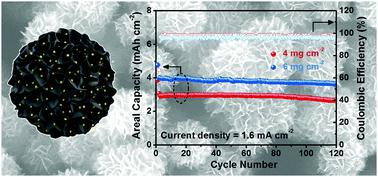当前位置:
X-MOL 学术
›
Nanoscale Horiz.
›
论文详情
Our official English website, www.x-mol.net, welcomes your
feedback! (Note: you will need to create a separate account there.)
Molybdenum carbide nanostructures for electrocatalytic polysulfide conversion in lithium-polysulfide batteries.
Nanoscale Horizons ( IF 8.0 ) Pub Date : 2019-11-06 , DOI: 10.1039/c9nh00618d Yunling Wu 1 , Jun Deng , Yuan Zhou , Yang Huang , Yanguang Li
Nanoscale Horizons ( IF 8.0 ) Pub Date : 2019-11-06 , DOI: 10.1039/c9nh00618d Yunling Wu 1 , Jun Deng , Yuan Zhou , Yang Huang , Yanguang Li
Affiliation

|
Introduction of appropriate cathode electrocatalysts in lithium–sulfur or lithium–polysulfide batteries can accelerate the polysulfide interconversion and suppress the shuttle effect. However, improvements are often limited especially under high sulfur loading. Herein, we prepare molybdenum carbide nanostructures and investigate their potential as the cathode electrocatalyst for lithium–polysulfide batteries. The product is prepared by the self-polymerization of dopamine in the presence of Mo7O246− ions, followed by high-temperature carburization. It features ultrasmall α-MoC1−x nanoparticles uniformly dispersed on a hierarchical carbonaceous support. Polysulfide adsorption experiments and electrochemical measurements show that this material has a strong surface affinity toward polysulfides, and can greatly enhance their conversion rate, in particular the Li2S4 ↔ Li2S2/Li2S conversion. When assessed as the cathode electrocatalyst, it enables lithium–polysulfide batteries with large specific capacity (up to 1400 mA h g−1), impressive rate capability (800 mA h g−1 at 3200 mA g−1) and excellent cycling stability even at high sulfur loading.
中文翻译:

碳化锂纳米结构,用于锂-多硫化物电池中的电催化多硫化物转化。
在锂硫或锂硫多硫化物电池中引入合适的阴极电催化剂可以加快多硫化物的相互转化并抑制穿梭效应。但是,改进常常受到限制,特别是在高硫负荷下。在这里,我们准备了碳化钼纳米结构,并研究了它们作为多硫化锂电池阴极电催化剂的潜力。该产品是通过在Mo 7 O 24 6-离子存在下使多巴胺自聚合,然后进行高温渗碳来制备的。它具有超小α-的MoC 1- X纳米颗粒均匀地分散在分层的碳质载体上。多硫化物吸附实验和电化学测量结果表明,该材料具有朝向多硫化物很强的表面亲和力,并且可以大大提高其转化率,特别是锂2小号4 ↔栗2小号2 /锂2 S转换。当用作阴极电评估,它使用特定的大容量锂电池多硫化物(高达1400毫安汞柱-1),令人印象深刻的速率能力(800毫安汞柱-1在3200毫安克-1)和优异的循环稳定性,即使在高硫负荷。
更新日期:2019-11-06
中文翻译:

碳化锂纳米结构,用于锂-多硫化物电池中的电催化多硫化物转化。
在锂硫或锂硫多硫化物电池中引入合适的阴极电催化剂可以加快多硫化物的相互转化并抑制穿梭效应。但是,改进常常受到限制,特别是在高硫负荷下。在这里,我们准备了碳化钼纳米结构,并研究了它们作为多硫化锂电池阴极电催化剂的潜力。该产品是通过在Mo 7 O 24 6-离子存在下使多巴胺自聚合,然后进行高温渗碳来制备的。它具有超小α-的MoC 1- X纳米颗粒均匀地分散在分层的碳质载体上。多硫化物吸附实验和电化学测量结果表明,该材料具有朝向多硫化物很强的表面亲和力,并且可以大大提高其转化率,特别是锂2小号4 ↔栗2小号2 /锂2 S转换。当用作阴极电评估,它使用特定的大容量锂电池多硫化物(高达1400毫安汞柱-1),令人印象深刻的速率能力(800毫安汞柱-1在3200毫安克-1)和优异的循环稳定性,即使在高硫负荷。


















































 京公网安备 11010802027423号
京公网安备 11010802027423号